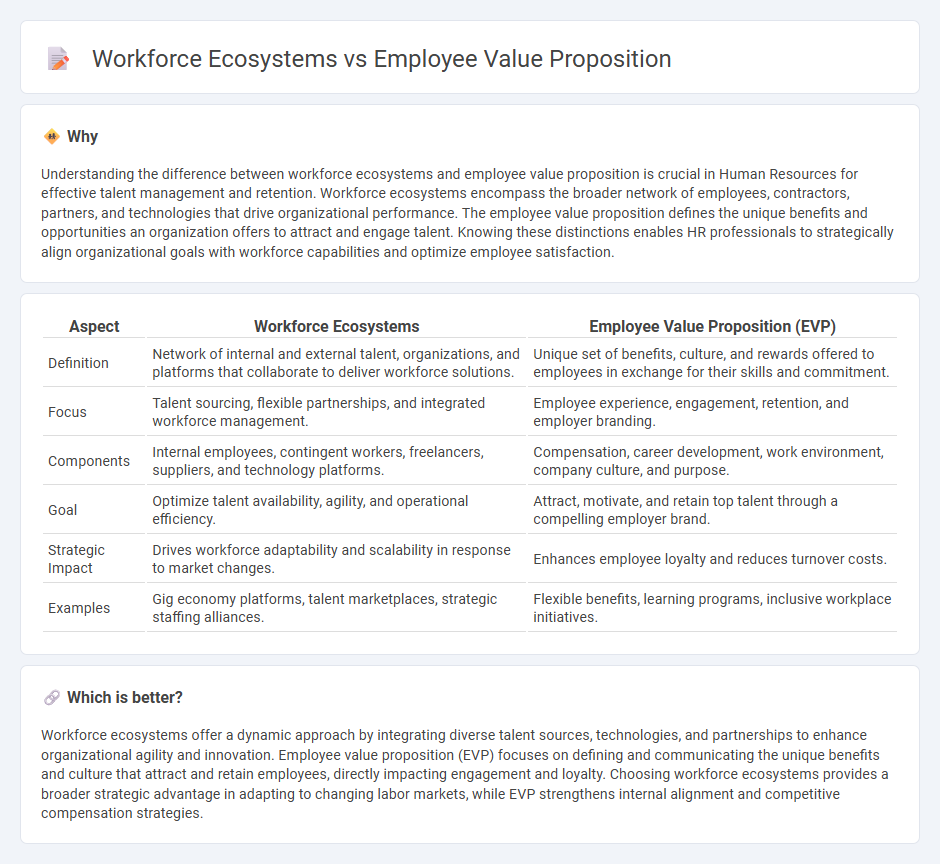
Workforce ecosystems encompass the interconnected network of employees, contractors, partners, and technology that drive organizational performance, offering a holistic approach to talent management. Employee Value Proposition (EVP) focuses on the unique set of benefits and rewards an organization provides to attract, engage, and retain talent, directly influencing workforce loyalty and productivity. Explore how integrating workforce ecosystems and EVP strategies enhances business agility and talent satisfaction.
Why it is important
Understanding the difference between workforce ecosystems and employee value proposition is crucial in Human Resources for effective talent management and retention. Workforce ecosystems encompass the broader network of employees, contractors, partners, and technologies that drive organizational performance. The employee value proposition defines the unique benefits and opportunities an organization offers to attract and engage talent. Knowing these distinctions enables HR professionals to strategically align organizational goals with workforce capabilities and optimize employee satisfaction.
Comparison Table
| Aspect | Workforce Ecosystems | Employee Value Proposition (EVP) |
|---|---|---|
| Definition | Network of internal and external talent, organizations, and platforms that collaborate to deliver workforce solutions. | Unique set of benefits, culture, and rewards offered to employees in exchange for their skills and commitment. |
| Focus | Talent sourcing, flexible partnerships, and integrated workforce management. | Employee experience, engagement, retention, and employer branding. |
| Components | Internal employees, contingent workers, freelancers, suppliers, and technology platforms. | Compensation, career development, work environment, company culture, and purpose. |
| Goal | Optimize talent availability, agility, and operational efficiency. | Attract, motivate, and retain top talent through a compelling employer brand. |
| Strategic Impact | Drives workforce adaptability and scalability in response to market changes. | Enhances employee loyalty and reduces turnover costs. |
| Examples | Gig economy platforms, talent marketplaces, strategic staffing alliances. | Flexible benefits, learning programs, inclusive workplace initiatives. |
Which is better?
Workforce ecosystems offer a dynamic approach by integrating diverse talent sources, technologies, and partnerships to enhance organizational agility and innovation. Employee value proposition (EVP) focuses on defining and communicating the unique benefits and culture that attract and retain employees, directly impacting engagement and loyalty. Choosing workforce ecosystems provides a broader strategic advantage in adapting to changing labor markets, while EVP strengthens internal alignment and competitive compensation strategies.
Connection
Workforce ecosystems enhance the employee value proposition by fostering interconnected networks of talent, technology, and organizational culture that support employee growth and engagement. An optimized workforce ecosystem integrates diverse skill sets and collaborative platforms, driving innovation and agility that attract and retain top talent. Strengthening this synergy improves overall organizational performance and employee satisfaction within competitive labor markets.
Key Terms
**Employee Value Proposition:**
Employee Value Proposition (EVP) defines the unique set of benefits, culture, and opportunities an organization offers to attract and retain top talent, emphasizing competitive compensation, career development, and workplace well-being. It serves as a strategic tool to enhance employee engagement and brand reputation, directly impacting recruitment and retention metrics in diverse labor markets. Explore how crafting a compelling EVP can transform your talent acquisition and retention strategies.
Employer Branding
Employee value proposition (EVP) defines the unique benefits and rewards an organization offers to its employees, shaping the core of employer branding. Workforce ecosystems encompass the broader network of talent, including freelancers, partners, and contractors, expanding the employer's reach and brand influence beyond traditional employees. Explore how integrating EVP with workforce ecosystems can transform your employer branding strategy and attract diverse talent.
Total Rewards
Employee Value Proposition (EVP) emphasizes the unique set of benefits and rewards an organization offers to attract and retain talent, with Total Rewards encompassing compensation, benefits, career development, and work-life balance. Workforce ecosystems expand this concept by integrating a broader network of internal and external contributors, leveraging Total Rewards to foster engagement and collaboration beyond traditional employment relationships. Explore how aligning Total Rewards within employee value propositions and workforce ecosystems can drive organizational success and workforce agility.
Source and External Links
Employee Value Proposition (EVP): All You Need to Know in 2025 - An employee value proposition is the unique value an employer offers employees in exchange for their skills, experience, and commitment, typically including compensation, work-life balance, stability, location, and respect.
13 Inspiring Employee Value Proposition Examples That Work - An EVP is a combination of rewards and benefits--such as compensation, work-life balance, stability, location, and respect--that employees receive for their performance, helping attract talent and reduce turnover by clearly communicating what makes the company a supportive place to work.
Employee Value Proposition (EVP): Definition and Guide - An EVP is a statement outlining the values, rewards, recognition, support, and company culture an employer provides, enabling employees to do their best work and achieve their potential, while differentiating the company from competitors.
 dowidth.com
dowidth.com